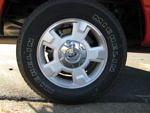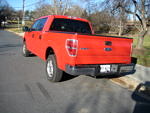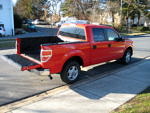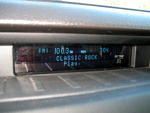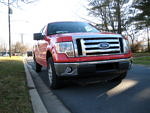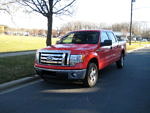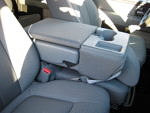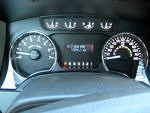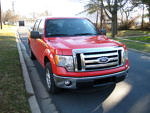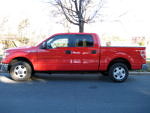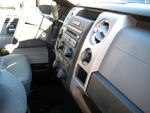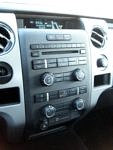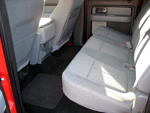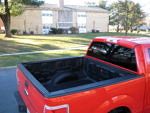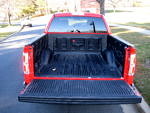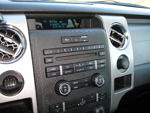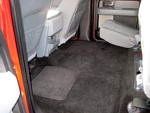 While the 2013 F-150s have been on sale for a few months now, there are many leftover 2012s, and some used ones are hitting the dealership lots as well. A couple of months ago, my own F-150 was involved in an accident (no fault of my own), which gave me the opportunity to drive a rented 2012 Ford F-150 XLT for 11 days while my truck was being repaired. The rental experience included some quality time with Ford’s relatively new 5.0-liter V8, code-named Coyote. The V8 gives the F-150 a very different personality from my own truck, which is equipped with Ford’s EcoBoost twin-turbocharged V6. Read on for more details and my review.
While the 2013 F-150s have been on sale for a few months now, there are many leftover 2012s, and some used ones are hitting the dealership lots as well. A couple of months ago, my own F-150 was involved in an accident (no fault of my own), which gave me the opportunity to drive a rented 2012 Ford F-150 XLT for 11 days while my truck was being repaired. The rental experience included some quality time with Ford’s relatively new 5.0-liter V8, code-named Coyote. The V8 gives the F-150 a very different personality from my own truck, which is equipped with Ford’s EcoBoost twin-turbocharged V6. Read on for more details and my review.


As a refresher, I invite you to peruse my review of the 2011 Ford F-150 Lariat, a truck I purchased back in October of 2011. While both the 2011 F-150 that I own and this 2012 F-150 are both Fords, and are both F-150s, the trucks differ quite a bit from there. Besides the rental being a SuperCrew cab with a 5.5′ bed versus my truck, which is a SuperCab with a 6.5′ bed, my Lariat trim-level truck has 4WD, heated and cooled power leather seats, navigation, sunroof, 10-speaker Sony audio, SYNC, and a raft of other amenities, the 2012 F-150 rental was a 2WD XLT, with nary an option save the aforementioned 5.0-liter Coyote V8. What did this mean for the every day ownership experience? Not as much as I thought. (See above – two pictures detailing the exterior dimensional differences between my truck and the rental.)
 Even though the 2012 F-150 was sparsely optioned, it certainly isn’t penalty box on wheels. Quite the opposite – there were far fewer distractions, and the cloth bench seat was quite comfortable, as was the fold-down armrest, which can be folded up to seat a total of 6 in the cab. The only added distraction over my own truck was the manual climate control. Whereas an automatic climate control system is a “set-and-forget” operation, I was quite often reaching over for the chunky fan, temperature and vent controls. A lot of this is due to the larger interior dimensions of a truck, as compared with most passenger vehicles. A truck’s HVAC system just has to work harder to maintain the same temperature. The beauty of the F-150 (and most trucks), is that physical controls are easy to manipulate, and feel substantial, something that you don’t usually get in the passenger-car segment. The only amenities I really missed, besides the aforementioned automatic climate control, were the sunroof, backup camera, SYNC and Sirius satellite radio.
Even though the 2012 F-150 was sparsely optioned, it certainly isn’t penalty box on wheels. Quite the opposite – there were far fewer distractions, and the cloth bench seat was quite comfortable, as was the fold-down armrest, which can be folded up to seat a total of 6 in the cab. The only added distraction over my own truck was the manual climate control. Whereas an automatic climate control system is a “set-and-forget” operation, I was quite often reaching over for the chunky fan, temperature and vent controls. A lot of this is due to the larger interior dimensions of a truck, as compared with most passenger vehicles. A truck’s HVAC system just has to work harder to maintain the same temperature. The beauty of the F-150 (and most trucks), is that physical controls are easy to manipulate, and feel substantial, something that you don’t usually get in the passenger-car segment. The only amenities I really missed, besides the aforementioned automatic climate control, were the sunroof, backup camera, SYNC and Sirius satellite radio.
 In the looks department, the rental was quite similar to my own truck, except mine is a SuperCab (extended cab) and the rental was a SuperCrew (crew cab), as I mentioned before. The wheelbases for both trucks are the same, which means a prospective buyer is trading bed space for people space when opting for a SuperCrew cab. If you need both cab space and extra bed space, the SuperCrew can be optioned with the 6.5′ bed, giving it a longer wheelbase as well. This 2012 F-150 was, sheetmetal-wise, the same as one of the first vehicles I reviewed, a 2010 F-150 Lariat. Unlike in that review, for this one, I actually had stuff to haul, including well over 1,000 lbs of freshly-cut firewood.
In the looks department, the rental was quite similar to my own truck, except mine is a SuperCab (extended cab) and the rental was a SuperCrew (crew cab), as I mentioned before. The wheelbases for both trucks are the same, which means a prospective buyer is trading bed space for people space when opting for a SuperCrew cab. If you need both cab space and extra bed space, the SuperCrew can be optioned with the 6.5′ bed, giving it a longer wheelbase as well. This 2012 F-150 was, sheetmetal-wise, the same as one of the first vehicles I reviewed, a 2010 F-150 Lariat. Unlike in that review, for this one, I actually had stuff to haul, including well over 1,000 lbs of freshly-cut firewood.
 For a truck with a little over 17,000 miles on its odometer, the interior had its share of wear and tear, but nothing too bad. Given that the designers and engineers designed the F-150 to work, this was not surprising. Given that it’s held up this well under rental use, is. Usually, the rental cars I get, with similar miles, show a lot more wear. I posit that the hard plastics, which are in widespread use in the F-150, hold up better than soft-touch plastics used in a lot of cars today.
For a truck with a little over 17,000 miles on its odometer, the interior had its share of wear and tear, but nothing too bad. Given that the designers and engineers designed the F-150 to work, this was not surprising. Given that it’s held up this well under rental use, is. Usually, the rental cars I get, with similar miles, show a lot more wear. I posit that the hard plastics, which are in widespread use in the F-150, hold up better than soft-touch plastics used in a lot of cars today.
 As with the 2010 F-150 I reviewed, the 2012 was spacious inside, but lacking in bed space. The lack of bed space wasn’t a huge issue, however, because nothing I needed to haul was very large. If your needs specify the SuperCrew cab, and your usual haunts won’t allow for a longer overall truck, then option Ford’s bed extender for a few hundred bucks. Regarding the bed, I’d be remiss if I didn’t mention the Tailgate Step. This $375 option is a must-have for today’s trucks, which feature taller bed sides (and thus, tailgates), at least for anyone shorter than 6′ tall. The lack of the optional Tailgate Step on the 2012 rental made it more of a chore to get into and out of the bed. Truck manufacturers have raised the beds on newer trucks so that the wheel wells don’t intrude into the bed as much. Ford’s solution is the Tailgate Step and GM has opted for molded-in hand-holds and bumper steps (on the upcoming Chevrolet Silverado / GMC Sierra trucks). It’s hard to say which solution is better, but for me, I’ll take the Tailgate Step – at 5’8″ tall, it’s easier for me to step up into the truck than trying to use the bumpers, which I’ve had to do when the tailgate is blocked and I still need to get into the bed.
As with the 2010 F-150 I reviewed, the 2012 was spacious inside, but lacking in bed space. The lack of bed space wasn’t a huge issue, however, because nothing I needed to haul was very large. If your needs specify the SuperCrew cab, and your usual haunts won’t allow for a longer overall truck, then option Ford’s bed extender for a few hundred bucks. Regarding the bed, I’d be remiss if I didn’t mention the Tailgate Step. This $375 option is a must-have for today’s trucks, which feature taller bed sides (and thus, tailgates), at least for anyone shorter than 6′ tall. The lack of the optional Tailgate Step on the 2012 rental made it more of a chore to get into and out of the bed. Truck manufacturers have raised the beds on newer trucks so that the wheel wells don’t intrude into the bed as much. Ford’s solution is the Tailgate Step and GM has opted for molded-in hand-holds and bumper steps (on the upcoming Chevrolet Silverado / GMC Sierra trucks). It’s hard to say which solution is better, but for me, I’ll take the Tailgate Step – at 5’8″ tall, it’s easier for me to step up into the truck than trying to use the bumpers, which I’ve had to do when the tailgate is blocked and I still need to get into the bed.
 As mentioned above, I did get a chance to test out the truck’s hauling capacity and driving dynamics when loaded, with between 1,200 and 1,400 lbs of freshly-cut logs in the bed. The verdict: thumbs up. The 5.0-liter V8 had plenty of grunt, even when saddled with the weight and a relatively low 3.31 rear axle gear ratio. I wouldn’t say you’d be able to hurry it up when loaded, but it did handle all that I threw at it. Even when unloaded, the torque difference between the 5.0-liter and EcoBoost is evident. For people that haul heavy loads or tow on a regular basis, I’d recommend opting for the 3.55 or 3.73 rear axle gear ratio, as it will give you much better performance in those situations. With 2WD and taller (numerically lower) gear ratio, the acceleration was not quite as good as my own truck, but with less rotational mass and over 400lbs less to haul around, the 2012 F-150 held its own, and braking was better than my 4WD EcoBoost truck. Also, with no turbos to spool up before the real power is put to the ground, the Coyote V8 has a much more linear throttle response, making it easier to drive smoothly. And, even though it’s down on power compared to the EcoBoost, the Coyote V8 has an ace up its sleeve: the exhaust note. Throughout the entire RPM range, it’s an intoxicating sound that EcoBoost-equipped F-150s are devoid of (the twin turbochargers on EcoBoost-equipped F-150s mute most of the exhaust noise). It’s such a nice, throaty growl that it makes it hard to keep your foot out of the gas pedal. Combined the Lariat trim-level’s higher amount of sound-deadening, I experienced a weird auditory trick when I got my truck back – it sounded as though I had one of my rear windows rolled down. In the Lariat F-150, equipped with the EcoBoost, you hear the engine noise from the front and wind noise from the back. In an XLT with the Coyote V8, you hear a little engine noise from up front, but that sweet exhaust note from the back.
As mentioned above, I did get a chance to test out the truck’s hauling capacity and driving dynamics when loaded, with between 1,200 and 1,400 lbs of freshly-cut logs in the bed. The verdict: thumbs up. The 5.0-liter V8 had plenty of grunt, even when saddled with the weight and a relatively low 3.31 rear axle gear ratio. I wouldn’t say you’d be able to hurry it up when loaded, but it did handle all that I threw at it. Even when unloaded, the torque difference between the 5.0-liter and EcoBoost is evident. For people that haul heavy loads or tow on a regular basis, I’d recommend opting for the 3.55 or 3.73 rear axle gear ratio, as it will give you much better performance in those situations. With 2WD and taller (numerically lower) gear ratio, the acceleration was not quite as good as my own truck, but with less rotational mass and over 400lbs less to haul around, the 2012 F-150 held its own, and braking was better than my 4WD EcoBoost truck. Also, with no turbos to spool up before the real power is put to the ground, the Coyote V8 has a much more linear throttle response, making it easier to drive smoothly. And, even though it’s down on power compared to the EcoBoost, the Coyote V8 has an ace up its sleeve: the exhaust note. Throughout the entire RPM range, it’s an intoxicating sound that EcoBoost-equipped F-150s are devoid of (the twin turbochargers on EcoBoost-equipped F-150s mute most of the exhaust noise). It’s such a nice, throaty growl that it makes it hard to keep your foot out of the gas pedal. Combined the Lariat trim-level’s higher amount of sound-deadening, I experienced a weird auditory trick when I got my truck back – it sounded as though I had one of my rear windows rolled down. In the Lariat F-150, equipped with the EcoBoost, you hear the engine noise from the front and wind noise from the back. In an XLT with the Coyote V8, you hear a little engine noise from up front, but that sweet exhaust note from the back.
 Overall, I consider the 2012 F-150 XLT to be a great work truck, and with a few options, like the Sony audio system, SYNC, and a tailgate step, it would make a pretty good commuter/weekend worker as well, without going all-out for the luxo-truck Lariat (or higher) trim levels. The XLT is Ford’s bread-and-butter truck, so I expect Ford to sell a lot of them, at least until the new GM and RAM trucks show up on dealership lots. The American Pickup Truck War shows no signs of stopping, let alone slowing down. With full-size pickup trucks achieving fuel economy numbers close to that of the new slew of larger unibody crossovers and SUVs, with the towing and payload capacity a lot of truck owners need and use on a regular basis, it ought to be a long time before Americans give up their pick up.
Overall, I consider the 2012 F-150 XLT to be a great work truck, and with a few options, like the Sony audio system, SYNC, and a tailgate step, it would make a pretty good commuter/weekend worker as well, without going all-out for the luxo-truck Lariat (or higher) trim levels. The XLT is Ford’s bread-and-butter truck, so I expect Ford to sell a lot of them, at least until the new GM and RAM trucks show up on dealership lots. The American Pickup Truck War shows no signs of stopping, let alone slowing down. With full-size pickup trucks achieving fuel economy numbers close to that of the new slew of larger unibody crossovers and SUVs, with the towing and payload capacity a lot of truck owners need and use on a regular basis, it ought to be a long time before Americans give up their pick up.
Competitors: Chevrolet Silverado 1500, Dodge Ram 1500, GMC Sierra 1500, Nissan Titan, Toyota Tundra
As-Tested:
Year: 2012
Make: Ford
Model: F-150 SuperCrew XLT 2WD
EPA Fuel Mileage: 15/21 City/Highway
Base Price: $32,760
Options:
$1,000: 5.0-liter V8
$0.00: 3.31 Ratio Regular Axle
Total: $33,760
Destination: $995
As-Tested Price: $34,755
Ford has an online Window Sticker viewer. Click here to view the Window Sticker for the actual test vehicle.
by John Suit

